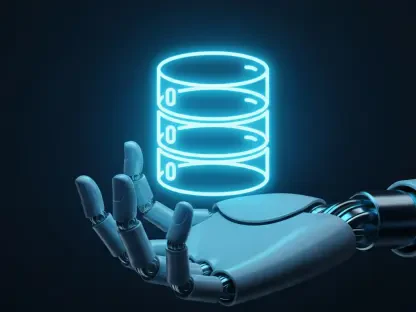Imagine a world where crafting software no longer demands endless hours of typing intricate lines of code, but instead, a simple English sentence can bring an entire application to life, revolutionizing the tech industry. This is the reality introduced by Vibe Coding, an AI-driven software development method that has taken the tech world by storm in 2025. Pioneered by visionaries like Andrej Karpathy, this technology promises to redefine how developers work, slashing time on projects and challenging traditional coding norms. Yet, beneath the surface of this innovation lies a pressing question: at what cost does this efficiency come to the workforce and software quality? This review delves into the heart of Vibe Coding, exploring its transformative features and the ripples it sends across the tech landscape.
Core Features of Vibe Coding
Low-Level Coding for Specific Snippets
Vibe Coding shines in its ability to handle low-level tasks with remarkable precision. Developers can input targeted prompts in plain English to generate specific code snippets, eliminating the need for manual scripting of repetitive or complex functions. This functionality proves invaluable for intricate components within larger projects, allowing for quick adjustments or debugging without deep dives into codebases.
The efficiency gains are evident, particularly in smaller, detail-oriented tasks where time savings can be substantial. By automating these elements, Vibe Coding reduces human error and frees up mental space for more strategic thinking. Reports from early adopters suggest a noticeable drop in time spent on mundane coding chores, reshaping how technical minutiae are managed.
This feature’s significance extends to maintaining focus on broader project goals while ensuring accuracy in the finer details. It serves as a powerful tool for developers tackling specialized challenges, integrating seamlessly into existing workflows. As a result, it has become a go-to for teams aiming to streamline their processes without sacrificing precision.
High-Level Coding for Full Applications
On the other end of the spectrum, Vibe Coding’s high-level capability allows for the creation of entire applications through broad, descriptive prompts. A developer might describe an app’s purpose and features in everyday language, and the AI constructs the necessary framework, often in a fraction of the time traditional methods require. This has accelerated development cycles dramatically for many tech firms.
The impact on rapid deployment is striking, with companies able to push products to market at unprecedented speeds. Real-world applications, such as a startup building a customer management platform in mere days, highlight how this tool transforms software creation from a months-long endeavor into a swift process. Such speed appeals to businesses racing to innovate.
This high-level approach not only boosts productivity but also democratizes app development, enabling those with minimal coding expertise to contribute meaningfully. However, it raises questions about the depth of customization and control compared to conventional methods. Nonetheless, its role in compressing timelines remains a game-changer for the industry.
Emerging Trends in AI-Driven Development
The tech sector is witnessing an unprecedented surge in AI integration, with Vibe Coding leading the charge among automation tools reshaping software development. Major firms are increasingly adopting these technologies to stay competitive, automating everything from code generation to testing protocols. This shift reflects a broader movement toward efficiency-driven innovation.
Industry behavior is evolving as a result, with a growing reliance on AI to handle tasks once reserved for human developers. This trend, while promising faster outputs, prompts a cautious outlook among experts who stress the importance of balancing automation with human oversight. The consensus points to a need for strategic implementation to avoid unintended pitfalls.
Expert opinions underscore this delicate equilibrium, advocating for policies that embrace progress while safeguarding against potential downsides like skill erosion. Many argue that while AI tools enhance productivity, they must complement rather than replace human ingenuity. This balance remains a critical discussion as adoption rates continue to climb.
Real-World Impact on Tech Jobs
Vibe Coding’s arrival has sent shockwaves through the tech job market, particularly affecting junior and mid-senior level software developers. As automation takes over routine coding tasks, the demand for traditional roles diminishes, leaving many professionals vulnerable. The scale of this disruption is already evident in significant layoffs across the sector.
A stark example comes from Tata Consultancy Services (TCS), which reduced its workforce by 12,000 positions this year due to the integration of automated coding solutions. This move illustrates a broader pattern where companies prioritize cost-saving technologies over human labor. Predictions suggest thousands more roles in coding, testing, and support could vanish in the near term.
The implications extend beyond immediate job losses, reshaping career paths and expectations within tech. Developers face pressure to pivot toward roles involving AI tool management or higher-level system design. Without adaptation, many risk obsolescence in an industry increasingly driven by machine efficiency, highlighting a profound shift in workforce dynamics.
Challenges and Limitations of Vibe Coding
Despite its promise, Vibe Coding introduces significant challenges, chief among them being widespread job displacement. The automation of core development tasks threatens workforce stability, creating uncertainty for countless professionals. This disruption demands urgent attention from industry leaders to address the human cost of technological advancement.
Concerns also arise regarding the quality of AI-generated code, with experts cautioning that over-reliance on such tools could lead to productivity losses. Flaws in automated outputs, if not rigorously vetted, risk degrading software standards, potentially undermining trust in critical systems. This issue looms large as adoption grows.
Efforts to mitigate these drawbacks are underway, including retraining programs aimed at equipping developers with skills for an AI-centric landscape. Such initiatives focus on transitioning workers to roles that complement automation, though scaling these solutions remains a hurdle. Addressing both job security and quality concerns is paramount for sustainable progress.
Future Outlook for Vibe Coding
Looking ahead, Vibe Coding is poised to evolve further, potentially becoming a cornerstone of software development practices. Anticipated advancements in AI algorithms could enhance its precision and versatility, addressing current limitations. This trajectory suggests deeper integration into industry workflows over the coming years.
The long-term impact may redefine how tech projects are conceptualized and executed, pushing boundaries of speed and accessibility. However, this evolution will likely intensify debates around workforce implications and ethical considerations. Striking a balance between innovation and stability will be crucial for shaping a positive future.
Industry stakeholders must develop strategies to harmonize technological growth with human capital needs, ensuring that progress does not come at the expense of livelihoods. Investments in education and policy frameworks could play a pivotal role in this adaptation. The path forward hinges on proactive measures to navigate these complex dynamics.
Final Assessment
Reflecting on this evaluation, Vibe Coding emerges as a revolutionary force that redefines efficiency in software development. Its ability to streamline both minute tasks and expansive projects marks a significant leap forward, captivating tech firms with its speed. Yet, the shadow of job displacement and quality concerns looms large over its achievements.
Moving forward, the tech sector must prioritize actionable solutions to harness Vibe Coding’s benefits while mitigating its disruptions. Initiatives like widespread retraining and robust quality assurance protocols could pave the way for a balanced integration. Additionally, fostering collaboration between AI developers and policymakers might ensure that innovation supports rather than supplants the workforce.
As the industry stands at this crossroads, the next steps involve a commitment to adaptability—equipping professionals with tools to thrive alongside AI and establishing benchmarks for software integrity. Exploring hybrid models where human creativity complements automated efficiency offers a promising avenue. The challenge ahead is clear: to steer this powerful technology toward a future that uplifts both innovation and humanity.









